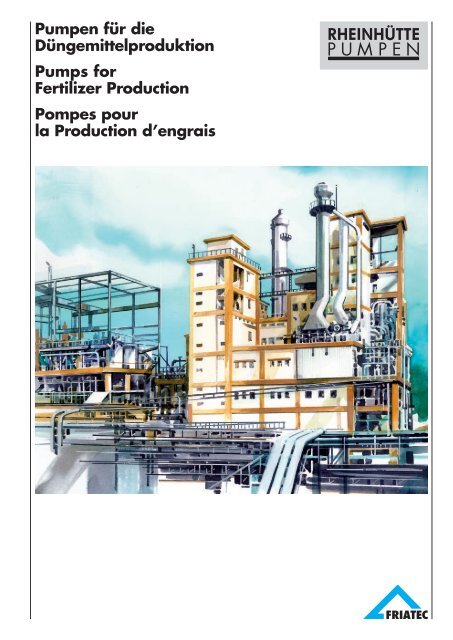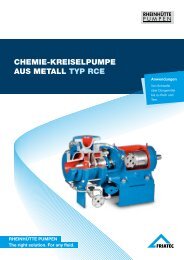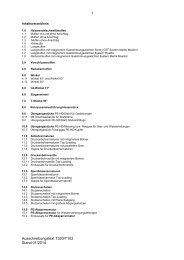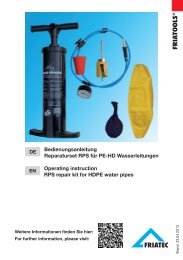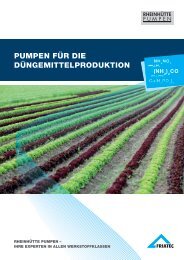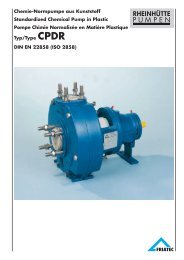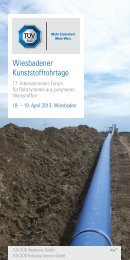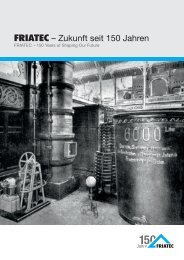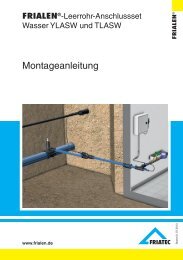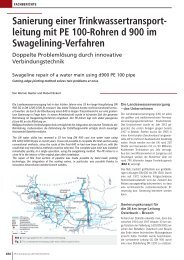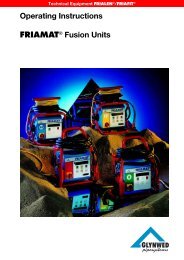Pumpen für die Düngemittelproduktion Pumps for Fertilizer ...
Pumpen für die Düngemittelproduktion Pumps for Fertilizer ...
Pumpen für die Düngemittelproduktion Pumps for Fertilizer ...
Create successful ePaper yourself
Turn your PDF publications into a flip-book with our unique Google optimized e-Paper software.
<strong>Pumpen</strong> <strong>für</strong> <strong>die</strong><br />
<strong>Düngemittelproduktion</strong><br />
<strong>Pumps</strong> <strong>for</strong><br />
<strong>Fertilizer</strong> Production<br />
Pompes pour<br />
la Production d’engrais
<strong>Pumpen</strong> <strong>für</strong> <strong>die</strong> <strong>Düngemittelproduktion</strong><br />
<strong>Pumps</strong> <strong>for</strong> fertilizer production<br />
Pompes pour la production d’engrais<br />
Düngemittel werden in der Landwirtschaft<br />
zur Erhöhung des Ertrages oder<br />
zur Beschleunigung des Wachstums von<br />
Nutzpflanzen eingesetzt. Sie wirken der,<br />
durch <strong>die</strong> intensive landwirtschaftliche<br />
Nutzung der Anbauflächen bedingten,<br />
Verarmung der Böden an Stickstoff,<br />
Phosphor und Kalium entgegen. Es<br />
gibt eine Vielzahl von Düngemitteln,<br />
deren Zusammensetzung den jeweiligen<br />
An<strong>for</strong>derungen angepaßt wird.<br />
Im folgenden wird auf <strong>die</strong> Herstellung<br />
einiger wichtiger Düngemittel wie Ammoniumnitrat<br />
NH 4 NO 3 , Ammoniumsulfat<br />
(NH 4 ) 2 SO 4 und NPK-Dünger eingegangen.<br />
Bei den Produktionsverfahren<br />
müssen korrosive und teilweise verschleißend<br />
wirkende Me<strong>die</strong>n gefördert<br />
werden (Phasengemisch fest/flüssig).<br />
Hier zeigt sich, daß oftmals erst der Einsatz<br />
robuster Kreiselpumpen in korrosions-<br />
oder auch verschleißbeständigen<br />
Werkstoffen eine wirtschaftliche Produktion<br />
ermöglichen.<br />
NH 4 NO 3 und (NH 4 ) 2 SO 4<br />
Die Herstellung von NH 4 NO 3 oder<br />
(NH 4 ) 2 SO 4 beruht auf der exothermen<br />
Neutralisationsreaktion von Salpetersäure<br />
bzw. Schwefelsäure mit Ammoniak<br />
NH 3 . Das Prinzip verdeutlicht das Bild<br />
anhand der Herstellung von (NH 4 ) 2 SO 4<br />
im Batch-Betrieb.<br />
<strong>Fertilizer</strong>s are used in agriculture to<br />
increase the yield or to accelerate the<br />
growth of economically useful plants.<br />
They oppose the exhaustion of the soil<br />
and in particular the loss of nitrogen,<br />
phosphorous and potassium in consequence<br />
of the intensive utilization of<br />
areas under cultivation. There is quite<br />
a number of fertilizers specially composed<br />
to suit individual requirements.<br />
In the following we will take a quick look<br />
at the production methods of some of<br />
the principal fertilizers like ammonium<br />
nitrate NH 4 NO 3 , ammonium sulphate<br />
(NH 4 ) 2 SO 4 and NPK fertilizers. Corrosive<br />
and partly abrasive fluids (phase mixture<br />
solid/liquid) have to be pumped during<br />
the production processes. There it turns<br />
out that in many cases economical<br />
production becomes possible only by<br />
employing heavy-duty pumps in corrosion-<br />
or in both corrosion- and wear<br />
resistant materials.<br />
NH 4 NO 3 und (NH 4 ) 2 SO 4<br />
The production of NH 4 NO 3 or (NH 4 ) 2 SO 4<br />
is based on the exothermic neutralizing<br />
reaction of nitric acid or sulphuric acid<br />
with ammonia NH 3 . The flow diagram is<br />
showing the principle of batch production<br />
of (NH 4 ) 2 SO 4 .<br />
Les engrais sont employés dans l’agriculture<br />
pour l’amélioration des rendements<br />
ou pour l’accélération de la croissance<br />
des plantes utiles. Ils agissent<br />
contre l’apauvrissement des sols en<br />
azote, phosphate et potassium par suite<br />
de l’exploitation intensive des surfaces<br />
agricoles. Il existe une grande variété<br />
d’engrais dont la composition convient<br />
à chaque exigence.<br />
Dans les lignes qui suivent, nous allons<br />
aborder la fabrication de quelques<br />
engrais importants comme le nitrate<br />
d’ammonium NH 4 NO 3 , le sulfate<br />
d’ammonium (NH 4 ) 2 SO 4 et les engrais<br />
NPK. Dans le processus de fabrication, il<br />
est nécessaire de véhiculer des produits<br />
corrosifs et parfois abrasifs (mélange<br />
solide/ liquide). Très souvent, l’emploi<br />
de pompes centrifuges robustes en<br />
matériaux résistant à la corrosion et à<br />
l’abrasion garantissent une production<br />
économique.<br />
NH 4 NO 3 und (NH 4 ) 2 SO 4<br />
La fabrication du NH 4 NO 3 ou du<br />
(NH 4 ) 2 SO 4 repose sur une réaction<br />
exothermique de neutralisation d’acide<br />
nitrique ou d’acide sulfurique avec de<br />
l’ammoniac NH 3 , Le schéma précise le<br />
principe sur la base de la fabrication de<br />
(NH 4 ) 2 SO 4 en traitement Batch.<br />
NH 3<br />
Filter<br />
Filtre 20 – 70 % H 2 SO 4<br />
P 1<br />
T ≤ 150 °C<br />
2NH 3 + H 2 SO 4<br />
↓<br />
(NH 4 ) 2 SO 4<br />
P3 P 2<br />
Trocknung<br />
To Drier<br />
Séchage<br />
2
Die <strong>Pumpen</strong> und <strong>die</strong> Werkstoffausführungen,<br />
<strong>die</strong> in <strong>die</strong>sem Verfahren<br />
erfolgreich eingesetzt worden sind:<br />
<strong>Pumps</strong> and materials of construction<br />
successfully used in this process are<br />
shown in the table below:<br />
Pompes et matériaux employés avec<br />
succès dans ce procédé:<br />
<strong>Pumpen</strong>-Nr. <strong>Pumpen</strong>typ Werkstoffe<br />
Pump No. Type of Pump Materials<br />
Pompe No. Type de Pompe Matériaux<br />
Eisensiliziumguß: Siguß (G-X 70 Si 15)<br />
P 1 RCE RNSi<br />
Silicon cast iron: Siguß (G-X 70 Si 15)<br />
Chemie Normpumpen Fronte au silicium: Siguß (G-X 70 Si 15)<br />
und Chemiepumpen<br />
R70 C1 (G-NiMo 17 Cr)<br />
Standardized Chemical <strong>Pumps</strong> 1.4136 S (G-X 50 CrMo 29 2)<br />
P 2 RCE RN and Chemical <strong>Pumps</strong> (temperaturabhängig)<br />
(dependent on temperature)<br />
Pompes Chimie Normalisées (en fonction de la température)<br />
et Pompes Chimie<br />
Eisensiliziumguß: Siguß (G-X 70 Si 15)<br />
P 3 RCE RNSi Silicon cast iron: Siguß (G-X 70 Si 15)<br />
Fonte au silicium: Siguß (G-X 70 Si 15)<br />
Für verfahrenstechnische Alternativen<br />
stehen ebenfalls <strong>die</strong> geeigneten horizontalen<br />
oder vertikalen <strong>Pumpen</strong> in bewährten<br />
Werkstoffausführungen zur Verfügung.<br />
Die Herstellung von NH 4 NO 3 er<strong>for</strong>dert<br />
<strong>die</strong> Förderung von ca. 65%iger HNO 3 .<br />
Hier bewährt sich der von der eigenen<br />
Werkstoffabteilung <strong>für</strong> <strong>die</strong> Salpetersäureeindampfung<br />
entwickelte Austenit<br />
1.4306 S bestens. Dieser Werkstoff findet<br />
auch zur Förderung des 95-98%igen<br />
NH 4 NO 3 bei Temperaturen von über<br />
100 °C Anwendung, das weiter zu Kalkammonsalpeter<br />
umgesetzt oder bei der<br />
Herstellung von NPK-Düngern verwendet<br />
wird. In zunehmendem Maße findet<br />
aber auch <strong>die</strong> wäßrige Ammoniumnitratlösung<br />
Verwendung als Flüssigdünger.<br />
Suitable horizontal or vertical pumps in<br />
proven materials are available <strong>for</strong> alternative<br />
processes.<br />
In the process of NH 4 NO 3 production<br />
HNO 3 of some 65 % concentration has<br />
to be pumped. Here best results have<br />
been achieved by using 1.4306 S (18/10)<br />
austenitic stainless steel, developed in<br />
Rheinhütte’s own Material Department<br />
<strong>for</strong> the evaporation of nitric acid. This<br />
material is used also <strong>for</strong> handling 95 to<br />
98% NH 4 NO 3 at temperatures above<br />
100 °C which is further converted into<br />
calcium ammonium nitrate or used in<br />
the production of NPK fertilizers. To an<br />
increasing extent aqueous ammonium<br />
nitrate solution is now applied as fluid<br />
fertilizer.<br />
Des pompes horizontales ou verticales<br />
en matériaux éprouvés sont également<br />
disponibles pour des alternatives techniques.<br />
L’élaboration du NH 4 NO 3 requiert le<br />
pompage de HNO 3 d’une concentration<br />
d’environ 65 %. L’acier austenitique<br />
1.4306 S (Z2CN 18.10) mis au point par<br />
notre propre laboratoire de matériaux<br />
pour la concentration d’acide nitrique<br />
s’avère le plus approprié. Ce matériau<br />
est également utilisé pour le pompage<br />
de NH 4 NO 3 concentré à 95-98 % à une<br />
température de plus de 100 °C et qui sert<br />
pour la fabrication de nitrate calcique<br />
d’ammoniaque ou d’engrais NPK. La<br />
solution aqueuse de nitrate d’ammonium<br />
est également utilisée comme engrais<br />
liquide.<br />
3
NPK-Dünger<br />
Die Herstellung von NPK-Mineraldüngern<br />
beginnt mit dem Aufschluß<br />
von gemahlenen Phosphaterzen durch<br />
Säure, meistens Salpetersäure.<br />
Die anschließende Aufarbeitung und<br />
weitere Umsetzung führen schließlich<br />
zum fertigen Produkt sowie zum Teil<br />
wichtigen Nebenprodukten wie<br />
Fluorokieselsäure, <strong>die</strong> aus SiF 4 gewonnen<br />
wird.<br />
Wie das vereinfachte Fließbild zeigt, sind<br />
in <strong>die</strong>sem Prozeß zahlreiche <strong>Pumpen</strong> im<br />
Einsatz, <strong>die</strong> unterschiedliche Me<strong>die</strong>n<br />
fördern.<br />
Nachfolgende Tabelle zeigt <strong>die</strong> im Fließbild<br />
auf Seite 5 dargestellten <strong>Pumpen</strong>.<br />
NW <strong>Fertilizer</strong><br />
The production of NPK mineral fertilizers<br />
starts with the digestion of ground phosphate<br />
rock by means of acid, mostly by<br />
nitric acid.<br />
Subsequent processing and further<br />
conversions lead to the final product and<br />
to partly important by-products such as<br />
fluorosilicic acid which is produced from<br />
SiF 4 .<br />
As shown in the simplified flow sheet<br />
numerous pumps handling different<br />
fluids are installed in this process<br />
system.<br />
The table below is showing the pumps<br />
installed as per flow diagram on page 5.<br />
Engrais NPK<br />
La fabrication d’engrais minéraux NPK<br />
commence par la dissolution dans l’acide<br />
le plus souvent de l’acide nitrique, de<br />
minerai broyé de phosphate.<br />
Le retraitement qui s’ensuit ainsi que<br />
différentes trans<strong>for</strong>mations aboutissent<br />
en fin de compte au produit fini ainsi<br />
qu’en partie à différents produits<br />
annexes importants comme l’acide<br />
fluosilicique obtenu à partir du SiF 4<br />
(fluorure de silicium).<br />
Comme le montre le schéma simplifié<br />
de nombreuses pompes véhiculant<br />
différents produits sont en service.<br />
Le tableau ci-dessous montre les<br />
pompes représentées dans le schéma<br />
page 5.<br />
<strong>Pumpen</strong>-Nr. <strong>Pumpen</strong>typ Werkstoffe<br />
Pump No. Type of Pump Materials<br />
Pompe No. Type de Pompe Matériaux<br />
Chemie Normpumpe<br />
P 1 RN Standardized Chemical Pump 1.4306 S (G-X 2 CrNi 22 11)<br />
Pompe Chimie Normalisées<br />
Chemiepumpe<br />
P 2 – P 6 RCE Chemical Pump<br />
Pompe Chimie<br />
1.4136 S (G-X 50 CrMo 29 2)<br />
HA 28.5 (G-X 5 CrNiMoCu 28 5)<br />
Chemie Normpumpe<br />
P 7 – P 8 RN Standardized Chemical Pump<br />
Pompe Chimie Normalisées<br />
1.0619 (GS-C 25)<br />
1.4408 (G-X 6 CrNiMo 18 10)<br />
Flüssiggaspumpe<br />
P 9 RSG Liquefied Gas Pump Aluminium (3.2371) G-AISi 7 Mg<br />
Pompe pour Gaz Liquéfiés<br />
4
Phosphaterz<br />
Phosphate rock<br />
Minerai de<br />
phosphate<br />
SiF 4<br />
Salpetersaure<br />
Nitric acid<br />
Acide nitrique<br />
Kühlflüssigkeit<br />
Cooling liquid<br />
Liquide de<br />
refroidissement<br />
Wasser<br />
Water<br />
Eau<br />
Ammoniak<br />
Ammonia<br />
Ammoniac<br />
P 9<br />
Pottasche<br />
Potash salt<br />
Potasse<br />
P 1 P 7 P 81<br />
Calciumnitratschmelze<br />
Calcium nitrate melt<br />
Nitrate de calcium fondu<br />
Dampt<br />
Steam<br />
Vapeur<br />
Sand<br />
Sand<br />
Sable<br />
60-<br />
80 °C<br />
P 3<br />
Calciumnitrat<br />
Calcium nitrate<br />
Nitrate de calcium<br />
Dampt<br />
Steam<br />
Vapeur<br />
P 6<br />
Zur weiteren<br />
Verarbeitung<br />
For further<br />
processing<br />
Pour traitement<br />
ulterieur<br />
P 2 P 4 P 5<br />
NPK<br />
Ammoniumnitrat<br />
Ammonium nitrate<br />
Nitrate d’ammonium<br />
Auffallend ist, daß sich in der Praxis der<br />
Werkstoff 1.4136 S in den <strong>Pumpen</strong>positionen<br />
2 bis 6 bewährt hat. Dabei sind<br />
einige <strong>die</strong>ser <strong>Pumpen</strong> aufgrund eines<br />
aus den Phosphaterzen stammenden<br />
Feststoffanteils zusätzlich verschleißgefährdet.<br />
Auch hier zeigt der aus der<br />
eigenen Werkstoffentwicklung stammende<br />
ferritische Werkstoff 1.4136 S<br />
eine gute Beständigkeit. Diese beruht<br />
nicht zuletzt auf dem Werkstoffgefüge,<br />
das aus Chromferrit und Eisen-Chromcarbiden<br />
besteht.<br />
In bezug auf <strong>die</strong> praktische Anwendung<br />
korrosions- und verschleißfester Werkstoffe<br />
<strong>für</strong> <strong>die</strong> <strong>Düngemittelproduktion</strong><br />
verfügt <strong>die</strong> FRIATEC-Rheinhütte über<br />
jahrzehntelange und solide Erfahrungen.<br />
Sie reichen vom Aufschluß der unterschiedlichen<br />
Phosphaterzqualitäten über<br />
<strong>die</strong> Förderung von Harnstoffschmelzen<br />
bis zur Produktion von Mineraldüngern<br />
variabler Zusammensetzung nach<br />
verschiedenen Verfahren.<br />
5<br />
It is remarkable that 1.4136 S (30 % Cr)<br />
material has proved suitable <strong>for</strong> pump<br />
items 2 to 6. Some of these pumps are<br />
additionally subject to abrasion due to<br />
the solids originating from the rock. Here<br />
again the ferritic 1.4136 S material<br />
developed in Rheinhütte’s Material<br />
Department turned out as satisfactorily<br />
resistant, mainly owing to the material<br />
structure <strong>for</strong>med by chromium ferrite and<br />
ferro chromium carbides.<br />
As far as the practical application of<br />
corrosion- and wear-resistant materials<br />
in fertilizer production is concerned<br />
FRIATEC-Rheinhütte have decades of<br />
experience, covering <strong>for</strong> instance the<br />
digestion of many different sorts of<br />
phosphate rock, handling of urea melt<br />
and production of mineral fertilizers in<br />
various compositions and to different<br />
processes.<br />
Il convient de remarquer que dans la<br />
pratique, le matériau 1.4136 S (fonte à<br />
30 % de Cr) a fait ses preuves pour les<br />
pompes position 2 à 6.<br />
De plus, certaines de ces pompes sont<br />
soumises à l’usure des particules solides<br />
provenant du minerai de phosphate. Le<br />
matériau ferritique 1.4136 S montre dans<br />
ce cas une bonne résistance. Cela<br />
repose notamment sur la structure du<br />
matériau qui contient également du<br />
ferrite de chrome et du carbure de<br />
chrome et de fer.<br />
Se basant sur l’utilisation pratique de<br />
matériaux résistant à la corrosion et à<br />
l’abrasion, FRIATEC-Rheinhütte dispose<br />
d’une solide expérience depuis de longues<br />
années. Cela va de la dissolution<br />
de différentes qualités de minerai de<br />
phosphate en passant par le pompage<br />
de l’urée en fusion jusqu’à la production<br />
d’engrais minéraux de composition<br />
variable suivant différents procédés.
RCE..BH<br />
RCE..BH<br />
● Besonders robuste Lagerbockkonstruktion; hydrodynamische<br />
Wellenabdichtung durch Laufrad-Rückenschaufeln und<br />
Entlastungsrad; Sperrmediumanschluß; Saugdeckel und<br />
Dichtungseinsatz heizbar.<br />
● Heavy duty bearing pedestal construction; hydrodynamic<br />
shaft sealing by impeller with back vanes and auxiliary impeller;<br />
seal liquid connection; heating jackets on suction cover<br />
and seal insert.<br />
● Construction avec chaise de palier particulièrement robuste;<br />
étanchéité d’arbre hydrodynamique par un turbine avec<br />
ailettes dorsales et turbines auxiliaires; raccord de liquide de<br />
blocage; réchauffage du couvercle d’aspiration et du flasque<br />
de garniture.<br />
RN..CS<br />
RN..CS<br />
● Stationäre Einzel-Gleitringdichtung (Gleitring stationär,<br />
Gegenring rotierend); Freiraum um Gleitringdichtung gewährleistet<br />
intensives Umspülen und verhindert Ablagerungen;<br />
wahlweise mit/ohne Quench.<br />
● Stationary single mechanical shaft seal (spring loaded seal<br />
face stationary, seat rotating); generous space around seal<br />
allows intensive flushing, thus avoiding build-up of deposits;<br />
available with/without quench.<br />
● Garniture mécanique simple stationnaire (grain fixe<br />
stationnaire, contre-grain tournant); le dégagement autour<br />
de la garniture mécanique favorise un rinçage intensif et évite<br />
les bouchages et dépôts; éxécution avec ou sans quench.<br />
RNSi..B<br />
RNSi..B<br />
● Hydrodynamische Wellenabdichtung; entlastete Stopfbuchspackung;<br />
keine Spül- und Sperrflüssigkeit er<strong>for</strong>derlich;<br />
Betriebstemperaturen bis 300 °C; korrosions- und verschleißfester<br />
<strong>Pumpen</strong>werkstoff.<br />
● Hydrodynamic shaft sealing; relieved stuffing box packing;<br />
quench and seal liquids not necessary; operating temperature<br />
up to 300 °C; corrosion- and wear-resistant pump material.<br />
● Etanchéité d’arbre hydrodynamique, convient pour liquides<br />
chargés avec une usure minime; presse-étoupe déchargé;<br />
ne nécessite pas de fluide d’arrosage ni de blocage; températures<br />
de service jusqu’à 300 °C; matériaux de pompe résistant<br />
à la corrosion et à l’abrasion.<br />
6
RCEV..A<br />
● Kein Gleitlager im Fördergut, dadurch trockenlaufsicher;<br />
großer Wälzlagerabstand; Doppelspiralgehäuse; geschlossenes<br />
Laufrad mit Vorder- und Rückenschaufeln; druckentlasteter<br />
Wellendurchtritt; Tauchtiefen bis 2000 mm<br />
RCEV..A<br />
● No submerged sleeve bearing (cantilever design), there<strong>for</strong>e<br />
no damage caused by dry running; arge antifriction bearing<br />
span; double volute; closed impeller with front and back<br />
vanes; shaft gland pressure relieved; submersion depth up<br />
to 2000 mm<br />
● Pas de palier immergé dans le liquide pompé, d’où protection<br />
contre la marche à sec; écartement important entre<br />
les roulements; volute à double spirale; turbine fermée avec<br />
ailettes frontales et dorsales; passage d’arbre déchargé;<br />
hauteur de suspension jusqu’à 2000 mm<br />
7
RHEINHÜTTE-<strong>Pumpen</strong> in der <strong>Düngemittelproduktion</strong><br />
RHEINHÜTTE-<strong>Pumps</strong> in fertilizer production<br />
Pompes RHEINHÜTTE pour la production d’engrais<br />
Chemie-Kreiselpumpen Typ RCE 80/260 BH zur Förderung von Harnstoffschmelze<br />
in einer Düngemittelfabrik.<br />
Chemical centrifugal pumps type RCE 80/260 BH <strong>for</strong> pumping urea<br />
melt in a fertilizer factory.<br />
Pompes chimie centrifuge type RCE 80/260 BH véhiculant de l’urée<br />
dans une usine de fabrication d’engrais.a<br />
Chemie-Normpumpen Typ RN in der Düngemittelherstellung.<br />
Standardized chemical pumps type RN in fertilizer production.<br />
Pompes chimie normalisées type RN dans la production d’engrais.<br />
Bau<strong>for</strong>m BH – Laufrad mit Vorder- und Rückschaufeln, nachgeschaltetes<br />
Entlastungsrad, Saugdeckel und Stopfbuchsgehäuse heizbar.<br />
Design BH – Impeller with front and back vanes, additional auxiliary<br />
impeller, suction cover and stuffing box housing with heating jackets.<br />
Exécution BH – Turbine avec ailettes frontales et dorsales, turbine<br />
auxiliaire de décharge, couvercle d’aspiration et boîte de garniture<br />
réchauffés.<br />
Bau<strong>for</strong>m BH – hier mit Heizleitungen zur Förderung von Harnstoffschmelze<br />
bei 140 °C.<br />
Design BH – with manifolded heating jacket connection pipes <strong>for</strong> urea<br />
melt at 140 °C.<br />
Exécution BH – ici avec tuyauteries de réchauffage, pour pompage<br />
d’urée à 140 °C.<br />
3.00.0012 – 1002 d-e-f<br />
FRIATEC-Rheinhütte GmbH & Co.<br />
Postfach / P.O.B. 12 05 45 • D-65083 Wiesbaden<br />
Rheingaustr. 96 -100 • D-65203 Wiesbaden<br />
Tel. +49 (0)611/604-0 • Fax +49 (0)611/604-328<br />
Internet: www.friatec.de • www.rheinhuette.de<br />
e-mail: info@rheinhuette.de • service@rheinhuette.de<br />
05 · 10.02 WST


